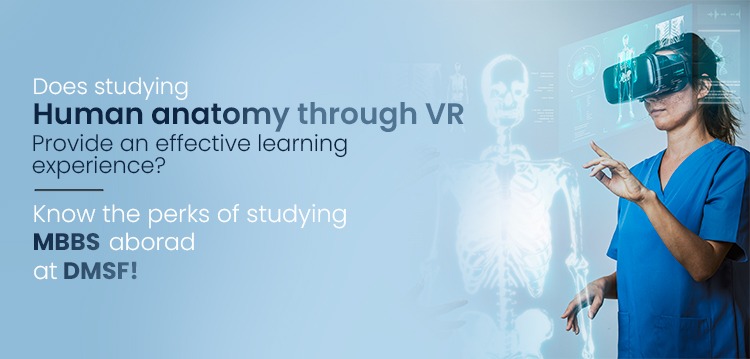
Does studying human anatomy through VR provide an effective learning experience?
Know the perks of studying MBBS abroad at DMSF!
VR Anatomy refers to the application of virtual reality (VR) technology in the field of human anatomy education and exploration. It involves the creation of immersive, interactive, and three-dimensional virtual environments that replicate the various systems and structures of the human body. VR Anatomy provides a unique opportunity for students, medical professionals, and enthusiasts to visualize and interact with complex anatomical structures, dissect virtual cadavers, and simulate surgical procedures, enhancing their knowledge, spatial understanding, and practical skills. By combining the power of virtual reality with the intricacies of human anatomy, VR Anatomy offers a revolutionary approach to education and training in the medical field.
Studying human anatomy through VR provides an extremely effective learning experience due to its immersive and interactive nature. Here are several reasons why VR enhances the learning of human anatomy:
1. Realistic Visualization: VR technology offers highly detailed and accurate anatomical models that closely replicate the structures of the human body. Users can examine organs, bones, muscles, and other anatomical components in a three-dimensional environment that closely mimics reality. This level of realism enables a deeper understanding of spatial relationships and the intricate details of the human anatomy.
2. Interactive Exploration: VR Anatomy allows users to interact with virtual models, enabling them to rotate, dissect, and manipulate anatomical structures. This hands-on approach enhances the learning experience by providing a sense of agency and active engagement. Users can explore different perspectives, zoom in on specific areas, and observe anatomical structures from various angles, facilitating a comprehensive understanding of the subject matter.
3. Enhanced Engagement and Focus: The immersive nature of VR creates a captivating learning environment that grabs and maintains the learner's attention. By eliminating distractions and providing a dedicated virtual space for anatomical study, VR helps students stay focused on the subject matter. The interactive nature of VR also promotes engagement and curiosity, as users actively participate in the learning process.
4. Mistake-Friendly Environment: VR Anatomy provides a safe and mistake-friendly environment for learning. Students can make virtual incisions, explore internal structures, and practice procedures without the fear of damaging real anatomical specimens or harming patients. This freedom to experiment and learn from mistakes fosters a sense of confidence and competence in students, allowing them to refine their skills and knowledge effectively.
VR Anatomy at DMSF
Davao Medical School Foundation (DMSF) is recognized as one of the premier colleges in the Philippines, particularly in the field of medicine. DMSF stands out for its commitment to providing students with exceptional learning resources to excel in their studies. Notably, DMSF has implemented innovative methodologies like VR anatomy, which greatly enhances the educational experience. By incorporating virtual reality technology, students at DMSF gain numerous advantages in their pursuit of medical knowledge. If you aspire to pursue a career in medicine and are considering an MBBS program, DMSF is a highly recommended institution. Admissions for the upcoming academic year are currently open, and you can secure your seat by contacting DMSF at 1800 833 7707. Take this opportunity to join DMSF and embark on a successful journey in the medical field.
